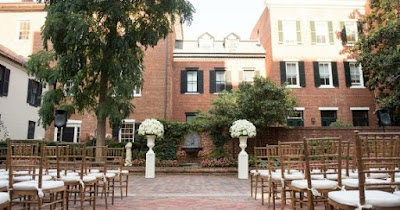Decatur house Washington, DC was constructed in 1818 as the first private residence, and a third building overall (after the White House and St. John’s Episcopal Church), built along Lafayette Square. The original building had three stories (currently four) and is a square-shaped red-brick structure designed in the popular Federal style.
 |
| Decatur House, Washington DC |
Stephen had won numerous battles during his command of the USS Constitution as part of the Barbary Wars and later aboard the USS United States in the War of 1812. When Decatur and his young bride moved to Washington in 1816, Stephen used monies awarded to him for his conquests to build a home along the northwest corner of Lafayette Square. His one request of Latrobe was that the home be constructed of hearty material and be “sturdy as a ship.’
Unfortunately, the Decaturs lived in, their blissful home for just over a year (fifteen months to be exact) before Stephen succumb to the challenges of a gentleman’s duel on March 22, 1820. The challenger was Commodore James Barron, who had felt slighted by a sentence bestowed upon him by Decatur. Barron held command of the American frigate Chesapeake in 1807 when it was attacked by a British warship, the HMS Leopard. After a single warning shot was fired upon the Chesapeake, Barron surrendered his ship without question. The British then boarded the Chesapeake and took four members of the Barron’s crew hostage after charging them as deserters of the Royal Navy. Barron, upon return, was reprimanded for his cowardice and was suspended for five years by a naval board that included Stephen Decatur. Seeking revenge for his now tarnished his image; Barron continued to challenge Decatur to a duel until the man agreed.
The duel amongst Decatur and Barron took place at 9 a.m. In Bladensburg, Maryland in a field adjacent to the town’s tavern. The men agreed to a face-to-face challenge that would be set at only eight paces. Each man got off a single shot. Decatur’s shot deflected off of Barron’s hip into his thigh and sent him sprawling to the ground, injured yet not mortally wounded. Barron’s shot, however, rang true and entered the pelvic area of Decatur. Decatur would be carried back to his home where he would pass away later that evening. At his funeral, it is said that over 10,000 people attended to pay their respects, including President James Monroe.
After Stephen’s death, Susan decided to move to a smaller home in nearby Georgetown and she began to rent out the Decatur House to visiting dignitaries over the course of the next fifteen years. Despite have left a sizeable inheritance, Susan found herself in mounting debt and she was forced to sell the home in 1836. Susan led a sad life after her husband’s death despite having numerous suitors including Aaron Burr. She would pass away in 1860, both childless and penniless.
The Decatur house Washington, DC was acquired in 1836 by a wealthy tavern owner named John Gadsby. Gadsby was also the proprietor of the well-known Gadsby’s Tavern located in Alexandria, VA and the former National Hotel located on Pennsylvania Avenue. Gadsby moved into the home with his wife Providence. During their residency, John constructed a two-story building directly behind his home. This building would serve as quarters for the slaves, which served his home. The structure still exists today and is a rare example of former slave quarters, which still reside within Washington.
The Federal Government seized the property during the Civil War for usage as storage space. After the war, in 1872, the home was acquired by General Edward Fitzgerald Beale. Beale had amassed his fortune during the California Gold Rush and was most famous for his failed efforts to establish a Camel Corps for the United States Army in the deserts of Arizona and New Mexico (the animals proved both slow and stubborn). The home remained in the Beale family for 84 years until 1956 when Marie Beale bequeathed the property to the National Trust for Historic Preservation. The home was opened as a museum beginning in the early 1960s.
The museum offers perspective into eight period rooms across two stories. In addition, the museum is currently in the process of being redesigned to serve as an educational center on the history of the nearby White House. During this renovation, the museum is temporarily closed. Continue to check the Decatur House website for updates as to its reopening. (And we will be sure to post hours and admission prices as soon as available.)
While passing by the Decatur house Washington, DC take a moment to glance up along the north side of the building along H Street, NW. Here you will see what appears to be a series of walled up windows. Legends tell of how upon Stephen Decatur’s death, his housekeepers would see his ghostly apparition on occasion looking out one of these windows. Supposedly upon hearing the tales, Susan immediately required that the relevant windows be walled up. As with all legends and tales, though, a fact usually trumps fiction.
It just so happens that the windows that appear as if they were walled up were never really windows. When Benjamin Latrobe was designing the Decatur House and he was installing a series of fireplaces, he was challenged with maintaining to his symmetrical Federal-style design. He could not likely install windows behind the fireplaces and thus the best he could do was to maintain the impression by carving out their ideal locales.
- Website: http://www.whitehousehistory.org/decatur-house/
- Address: 1610 H Street, NW, Washington, DC
- Cost: Free
